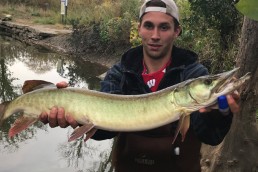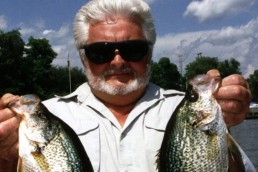SHARE THIS POST
One early summer morning around 4 a.m., the water was calm and a warm gentle breeze was coming out of the north on Center Lake. I launched my Native Slayer 10 into the water and secured it at the DNR dock off of Washington Drive. While walking back to the dock after parking my truck, I heard some splashing close by and immediately turned my headlamp toward the sound. Ripples and splashes continued as Mr. Tooth broke through the surface of the water. Swiftly, my heart skipped a beat and a glimpse of this monster pike’s head was visible as he chased after some baitfish. My excitement and adrenaline was flowing at lightning speed as my walking pace accelerated into a full sprint to the dock. All I could think about was going after my nemesis, the large northern, who had snapped my favorite fishing rod.
Unfortunately, the day was about to see an unexpected turn of events.
The dock was in view now and I couldn’t wait to slip into my kayak to chase after this beautiful old friend. As soon as my feet hit the dock, I slid off of the side and fell into the water. Of course, my life jacket was still in the kayak along with all of my safety gear. In addition to this dilemma, no one else was around the launch area to throw me a life ring, a PFD or at least a rope. I consider myself a pretty strong swimmer, but swimming was only a piece of remedying my problem—my legs were stuck in muck up to my knees.
After the shock of entering the water, my natural reaction was to plant my feet and walk out of the relatively shallow water. At first, slight panic began to set in and I knew that my stress levels needed to be kept in check in order to get out of the encapsulating sludge. Using one leg at a time while treading water with my arms, I was slowly able to break free. In the beginning, I tried fast movements and burned up quite a bit of energy as I sank deeper into the soft lake bottom. The successful technique I used was to carefully move my legs forward and backward then left and right in short movements with a strong force.
Are you enjoying this post?
You can be among the first to get the latest info on where to go, what to use and how to use it!
Finally, after quite a few minutes, I was able to break free. I swam to my kayak, and then climbed into the seat safely. Abruptly, I donned my life jacket and began relaxing with a cup of coffee and an energy bar.
I had learned the hard lesson of what can happen when safety measures are not my first concern. From that early, warm and humid summer day forward, I’ve always had the proper safety gear including a rain suit, signaling mirror, flashlight, an orange flag with a two-mile light, two life jackets, flares and a VHF radio. All of this proper equipment was not in reach when the accident had happened.
Presently, I put on a Stolquist Keeper life jacket as soon as my truck and kayak trailer are parked in the staging area of any body of water. Simply going through the ritual of first donning a life jacket, which can hold a variety of gear too, greatly increases my chances of surviving an unexpected situation. In this crucial, though multi-pocked PFD, I can put a VHF radio, orange hat, whistle, waterproof case with charged smartphone, a lifejacket light, rope, a hook and weight inside. By simply utilizing modern technology and some basic fishing gear, I feel like my possibility of surviving an accident has greatly improved.
Please consider making up your own survival life jacket and adopt the practice of wearing a proper PFD when you are around and on the water. All it takes is one fish and a lot of excitement for you to lose sight of safe-watersports practices. The old mindset is not there now, and a trophy fish can wait while safety procedures come first. I hope everyone has a safe and fun- filled, wonderful watersports season.
MWO
SHARE THIS POST
Did you enjoy this post?
You can be among the first to get the latest info on where to go, what to use and how to use it!



